Events
World Champions
| Year | Gold | Silver | Bronze |
|---|---|---|---|
| 2012 Riva del Garda [2] | Victoria Jurczok Anika Lorenz | Jule Görge Lotta Görge | SLeonie Meyer Elena Christine Stoffers |
| 29erXX Class symbol | |
| Boat | |
|---|---|
| Crew | 2 (twin trapeze) |
| Hull | |
| Hull weight | 74.25 kg (163.7 lb) |
| LOA | 4,450 mm (175 in) |
| Beam | 1.77 m (5 ft 10 in) |
| Rig | |
| Mast length | 7,626 mm (300.2 in) |
| Sails | |
| Gennaker area | 19.0 m2 (205 sq ft) |
| Upwind sail area | 15.0 m2 (161 sq ft) |
| Former class of World Sailing | |
The 29erXX is a high performance sailing skiff, it was designed to allow light crews, particularly female crews, to sail twin trapeze boats and as a training boat for the more powerful 49er. The class gained International Sailing Federation Class status in May 2011, but lost it in 2014. [1]
The 29erXX was designed by Julian Bethwaite with help from Jen Glass. The 29erXX is a high-powered rig for the existing 29er hull, indeed the new rig is extremely similar to the 29er's big brother - the 49er. This new rig is 0.45m longer than the standard 29er mast, and features carbon construction, double trapeze wires and three sets of shrouds. A masthead kite adds considerable speed downwind while the responsive 29er platform requires the sailors to move with precision through manoeuvres. Carbon tubes extend out the back of each rail to allow the crew to keep their weight further aft and the bow out of the water. Although initially many thought that the hull would be too small for its rig, extensive training on San Francisco Bay has disproved that notion. The lack of an adjustable rudder or other extra controls make the 29erXX a simple design, yet it is extremely sensitive to sailors' movements. 29erXX sailors must be incredibly athletic and coordinated as the skiff provides a continuous challenge to even the most advanced sailors.
The first international regatta was held in Weymouth, UK, in the summer of 2006. The event brought together 27 men's, women's and mixed teams from 8 countries providing valuable input to help make this a mature, well designed boat.
Downwind the 29erXX has a considerable advantage over the original 29er due to the increased sail size, masthead kite and the ability to have both crew members on the wire. Upwind the difference is less noticeable but again the 29erXX has the advantage.
In April 2007, at the Women's High Performance Dinghy Evaluation Event in Hyères, France, ISAF conducted extensive trials of the 29erXX as a possible choice for a women's high performance dinghy class at the 2016 Olympics
| Year | Gold | Silver | Bronze |
|---|---|---|---|
| 2012 Riva del Garda [2] | Victoria Jurczok Anika Lorenz | Jule Görge Lotta Görge | SLeonie Meyer Elena Christine Stoffers |

Dinghy sailing is the activity of sailing small boats by using five essential controls:

Dinghy racing is a competitive sport using dinghies, which are small boats which may be rowboats, have an outboard motor, or be sailing dinghies. Dinghy racing has affected aspects of the modern sailing dinghy, including hull design, sail materials and sailplan, and techniques such as planing and trapezing.
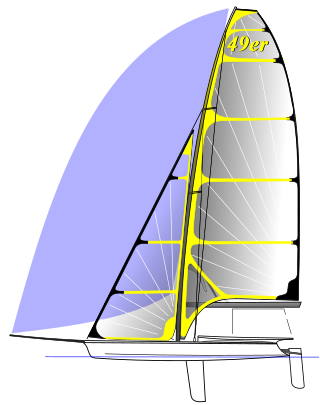
The 49er and 49er FX is a two-handed skiff-type high-performance sailing dinghy. The two crew work on different roles with the helm making many tactical decisions, as well as steering, and the crew doing most of the sail control. Both of the crew are equipped with their own trapeze and sailing is done while cantilevered over the water to the fullest extent to balance against the sails.

The International 505 is a One-Design high-performance two-person monohull planing sailing dinghy, with spinnaker, utilising a trapeze for the crew.
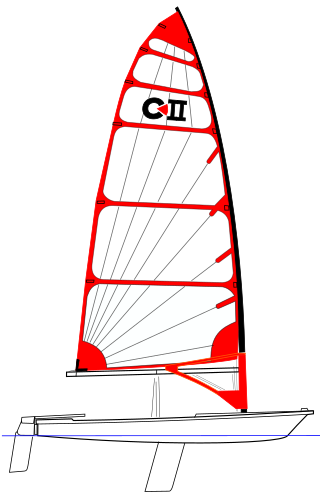
The Byte is a small one-design sailing dinghy sailed by one person. It was designed by Canadian Ian Bruce, who also commissioned and marketed the Laser.
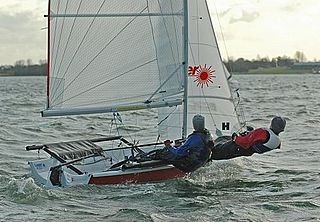
The Laser 4000 is a racing dinghy designed by Phil Morrison crewed by two persons. Its one-design weight-equalised system enables physically differing sailors to compete on a level playing field. It is most popular in Europe, particularly the UK, France and Italy.

The 29er is a two-person high performance sailing skiff designed by Julian Bethwaite and first produced in 1998. Derived from the Olympic class 49er class, it is raced in the ISAF Youth Sailing World Championships. The 29er is able to reach high speeds fairly quickly by having a sleek and hydrodynamic hull and will often exceed the wind speed when planing both up and downwind.

The 18 ft Skiff is considered the fastest class of sailing skiffs. The class has a long history beginning with races on Sydney Harbour, Australia in 1892 and later in New Zealand. The boat has changed significantly since the early days, bringing in new technology as it became available. Because of the need of strength, agility and skill, the class is considered to be the top level of small boat sailing. Worldwide this boat is called the "18 Foot Skiff". It is the fastest conventional non-foiling monohull on the yardstick rating, with a score of 675, coming only third after the Tornado and Inter 20.

The International 14 is a British racing sailboat, crewed by two sailors. The class was established in 1928.

In sailing, the trapeze is a wire that comes from a point high on the mast, usually where the shrouds are fixed, to a hook on the crew member's harness at approximately waist level. The position when extended on the trapeze is outside the hull, braced against it with the soles of the feet, facing the masthead, and clipped on by a hook on the trapeze harness. This gives the crew member more leverage to keep the boat flat by allowing the crew member's centre of gravity to balance the force of the wind in the sails.

The 12 ft Skiff is a development dinghy class dating back to the early 20th century. It is sailed in Australia and New Zealand. It is 12 ft (3.7 m) in length, hence the name, and is a two-man boat. Both the crew and the helm are able to use the trapeze at the same time. It has an asymmetrical spinnaker and a jib, in addition to the mainsail.

The Cherub is a 12 feet long, high performance, two-person, planing dinghy first designed in 1951 in New Zealand by John Spencer. The class is a development class, allowing for significant variation in design between different boats within the rule framework. The minimum hull weight was originally 110 lbs.
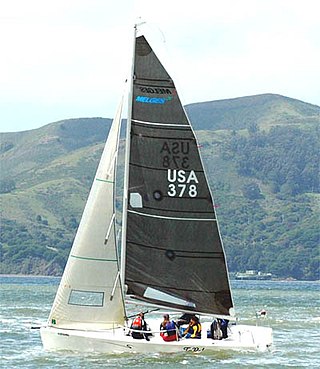
The term sportsboat first appeared in the late 1980s and early 1990s to describe trailer sailers that were optimised for high performance at the expense of accommodation and ballast. The very definition of the term "sportsboat" is evolving.
A 16 ft Skiff is a class of three-person sailing dinghy with twin trapezes and a large asymmetrical spinnaker. The class is unique to Australia, where it is one of the most popular boats sailing with 95 boats registered in 12 clubs. The class has the largest fleet of high performance skiffs on the east coast of Australia. Due to the nature of only allowing two trapezes, the age of the sailors can vary between 15 and 60 years old, making it a versatile class of boat.
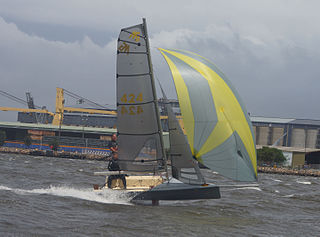
MG14 is a two-person skiff with a high-performance development hull, single trapeze and asymmetrical spinnaker.

The SKUD 18 is a class of racing sailing boat. It is a lead-assisted skiff with a tube-launched asymmetrical and a modern high performance stayed rig. The boat was created for trials held by the International Association for Disabled Sailing who were looking for a new two person boat for an additional medal allocated to sailing for the 2008 Paralympics.

The Farr 3.7 is a one-person sailing dinghy designed by Bruce Farr in 1971. The design plans are sold by the 3.7 Class Owners Association and they are built by a mix of professionals and home built by amateurs. The 3.7 Class is recognised by Yachting New Zealand as a national class and yachts are sailed in New Zealand, Australia and Great Britain. Full sets of plans have been sold worldwide to a number of individuals with greatest numbers in Germany, Japan, USA, South Korea, Poland, France, Belgium, Russia, Spain, Uruguay.

The B&R 23 is a sailing boat designed in the early 1990s. It has an ultralight construction with a very large sail plane. Typical crew is a helmsman and two deck hands in trapezes. The boat is predominantly used for racing.
Julian Bethwaite is an Australian, Sydney-based skiff sailor and sailboat designer. He wrote one chapter of his father Frank's book, Higher Performance Sailing.

The Topper Topaz is a British single-handed or two-handed sailing dinghy that was designed as a beginner and intermediate racer.